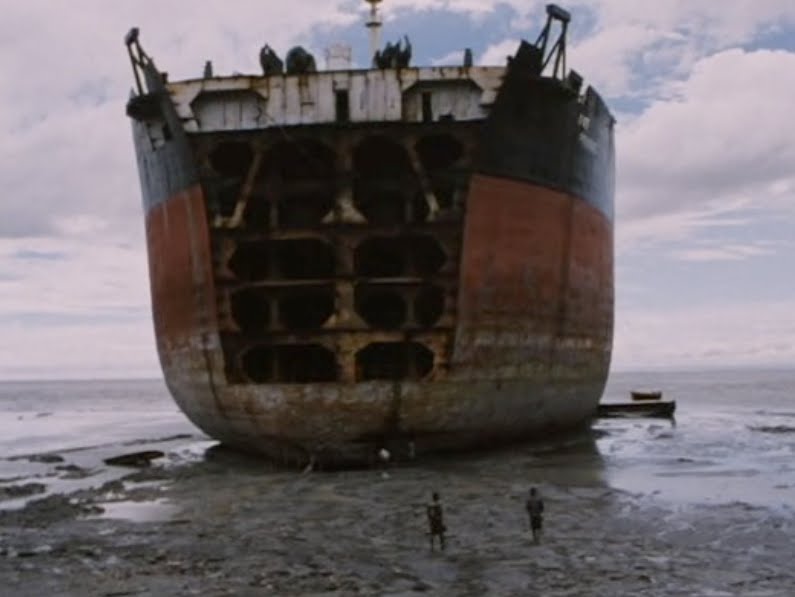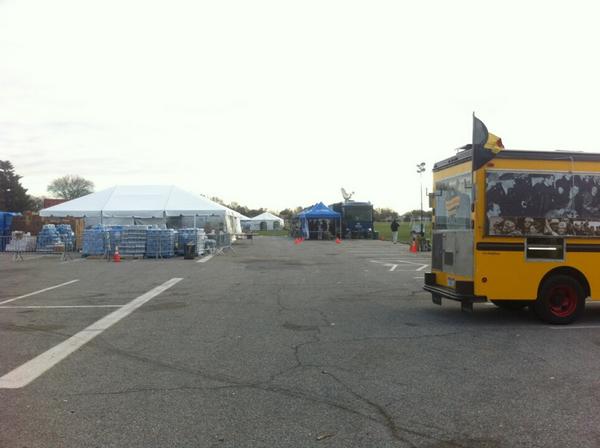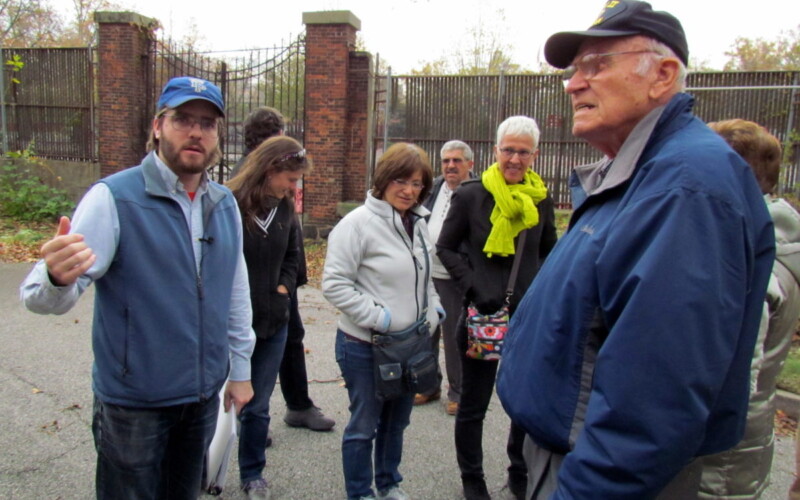Last month UnionDocs, a collective of documentary filmmakers based in Williamsburg, opened their season, and their newly renovated screening space, with a showing of two films by Peter Hutton about life – of men and ships – at sea. The screening was following by a discussion moderated by filmmaker Jem Cohen.
The first film, “Images of Asian Music,” was shot during Hutton’s time as a merchant seaman in Southeast Asia in the mid-1970’s. It’s an assemblage of images from sea and shore, where we see seamen killing time below decks, people fleeing from a Bangkok fireworks show gone awry, and an unforgettable scene of young girl curled up asleep with a gargantuan python. But my attention was more on the second film, “At Sea,” which traces the life cycle of a typical merchant vessel. It doesn’t follow a single ship, but uses three different ships as examples to illustrate the birth (in the shipyard), life (at sea), and death (in the scrapyard) that all ships go through.
The film opens in a shipyard in South Korea – immaculate, humming, vast. While shipyards are noisy, dirty places, we view the action from such a distance that you hardly notice that the film is silent – not quiet, but without any recorded sound. Going into the screening, I couldn’t image staying rapt to 60 soundless minutes of the sea going past, but that’s exactly what I was. Adding to my engagement was the fact that these are not films you can simply find on iTunes. Both were screened on 16mm prints, and “Images,” Hutton later admitted, was one of the first prints he had ever made of the film. The ship we watch being built – the Toledo Spirit, a 900-foot crude oil tanker – seemed fashioned more by machines than men. The shipyard workers appeared as distant figures, shrouded from head to toe in safety equipment, their faces covered. In fact, Hutton noted after the screening that throughout the filming, he was shadowed by representatives from the shipbuilding company who prevented him from getting close-up shots of any workers, and made sure none of their faces appeared on film. In nearly all the shots of people, they are in the distance, framed by the vastness of the ships and machinery around them. This frame makes their tasks seem impossible, endless, and futile – it left me with a feeling of dread and exhaustion. One such shot shows a solitary figure standing on a platform beneath the ship’s bow, polishing the Goliath by hand, an apparent lifetime’s work of scrubbing ahead. Yet somehow, the ship it completed; welded, riveted, painted and polished by the hands of thousands.
From Korea we turn to Montreal, where the container ship Houston Express is bound for Hamburg, Germany. Most of this segment was shot from the bridge, or somewhere near it, where we can watch the thousands of neatly stacked containers being whipped by the wind and waves of the North Atlantic. But that’s about all we see of the journey. There are no people, none of the mariners that filled the prior film with life below decks – the ship’s owner wouldn’t allow them to be filmed. Even the ship itself, Hutton noted, seemed automated, “missing the usual nautical cues” that makes a ship feel like a ship. This fact says much about modern shipping: containerization has increased the speed, efficiency, and volume of trade, yet it has reduced the need for people at sea and on shore. We have more ships, yet need fewer seamen to man them; more stuff, yet fewer people to load and unload it.
Finally, we arrive at the end of the ship’s life. Few ships die with dignity. While a tiny minority may live well past their working lives as attractions or museum pieces – in New York Harbor we can find great warships like the Intrepid or working vessels like the Lightship Ambrose that have found new leases on life – most are worked to death and limped to the shores of south Asia, where they can be broken apart and sold for scrap without regard for the safety of workers or the environment. In the opening segment, ships appeared born out of an almost sterile environment, magnificently clean and efficient; at the end, they are dismembered in a hellscape of grime and toil (Slate ran a good article on this practice in 2009).
The process of scrapping a ship, called shipbreaking, has been outsourced to the poorest corners of the world. Ships are very dirty things. They have lots of valuable scrap metal, but they are also filled with dangerous fuels and chemicals and toxic components that need to be disposed of. Rather than do this safely according to the regulations of the rich world, ship owners have decided to dump their charges on the shores of India, Pakistan, and Bangladesh, where they are picked over and split apart, mostly by hand. Far-off Staten Island was once the graveyard for New York’s fleet (and still is, in some cases), but global trade has enabled us to increase the distance between our lives and our dumping grounds.
Perhaps the most memorable shot in the film is of a man, seen from a distance, teetering on top of a 55-gallon drum swinging a sledgehammer. Below him, his friend crouches, holding a wedge in position; above him the beached ship towers for stories. And he is swinging his hammer downward, over and over again, with Sisyphean force and determination, trying to punch a hole in the side of the hull and extract whatever grim, oily treasures might be inside. Watching this scene, which is returned to several times, adding to the sense of futility, made my arms spasm with phantom exhaustion, as the mere thought of attempting to break apart this ship with nothing but a maul and wedge, muscle and sweat, left me spent, defeated (I can feel my arms turning to jell-o just recalling the image as I write this.) But the anonymous, distant toiler is not all we see of these shipbreakers. Hutton brings us up close with them, as they cart away massive ship shards in packs, and they smile and mug for the camera, and the despair fades a bit. But just a bit.
Both the Korean shipyard and its Indian counterpart induced in me a sense of dislocation and dread, but for completely different reasons. The yard is huge, anonymous and alienating, yet the process appears efficient and safe; meanwhile, the shipbreaking is dangerous, violent, and impossibly filthy, yet it is a landscape populated by real people with faces and emotions. As a result, this life cycle presents many contradictions and discontinuities. The narrative (or what there is of one) is indeed linear, but the settings leave you with the feeling that time is reversed; as Hutton put it, “We start in the future, and end in the past.” Or rather, we travel to the two sides of our present – the sleek, efficient surface of global capitalism, and the frightening poverty and desperation of the legions of humanity that keep it running.
I should note again that all of this drama between human and vessel unfolds in silence, but you hardly notice it; in fact, I don’t know that I’ve seen a louder film. Hutton says that his commitment to silent film is because it makes him a better, more focused filmmaker – “Keep it simple,” as he says. But when one sense is deprived, the mind has a way of filling the void. I can’t say for certain that I didn’t hear the sound of the Atlantic gale, or of the hammer pounding into rusty metal, or the men in India laughing, though it seems impossible. While immersed in “At Sea,” I know I heard something.





